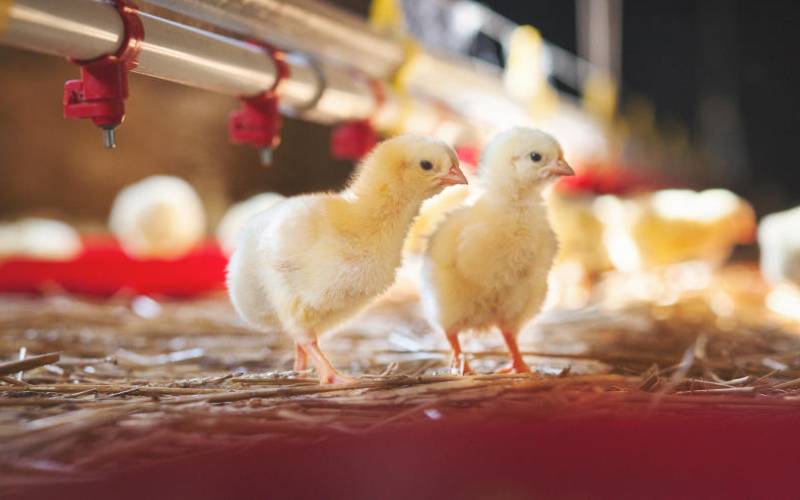
Are you losing your chicks at zero to two weeks of age? Here are the eights possible reasons. Although most mortality occur within the first two weeks, later mortality can cause huge financial loss to farmers considering the loss in birds as well as the feeds and other resources invested in growing them. Here are eight most common cause of early mortality in the first two weeks of life.
Mismanagement
Mismanagement is the single biggest contributor to early chick mortality. Things can easily go wrong way back before the chicks’ arrival.
To avoid needless deaths, the units must be properly cleaned and disinfected using effective chemicals in the right amount and concentration.
The old litter must be properly disposed off the site and the units rested for not less than 18-21 days.
On date of chick arrival, make sure that you have a well established standard operating procedures for brooding chicks which is strictly adhered to.
Ensure the birds have sufficient space around the feeders and waterers, make sure that there are enough feed, water, and that ventilation system is working. As the birds age any type of stress can trigger loss of function and death.
Starve-out/starvation
At placement, chicks are hungry and we expect high activity at the feeders as they eat to fill up their crops.
Carry out a crop fill test during the first 24 hours by taking a sample of 30-40 chicks from four different places in the flock house and feeling for fullness of the crop.
Within the first four hours of feeding, 80 per cent of the crops should be full while at 24 hours of placement, 95-100 per cent of the crops should be full. Starved chicks will die very fast due to luck of glucose.
Omphalitis/yolk sac infection
Omphalitis refers to infection of the yolk sac and the navel and it causes the reddening and swelling around the umbilical region. This condition is primarily related to poor hygienic conditions, dirty hatcheries and dirty beddings in the poultry units. Chose your chick supplier carefully and avoid if you can, imported chicks with no known history. Keep your litter dry and friable all the time.
Vaccine contamination
Stay informed. Subscribe to our newsletter
Contaminated vaccines applied either at the hatcheries or in the farm can cause post vaccination reactions leading to respiratory infections. This is common when applying vaccinations against Newcastle and Infectious bronchitis at day one or at day 7-14, ensure that the vaccines are not mixed with dirty water or expired diluent.
Cannibalism
This applies to damage caused by another bird during pecking behaviour. Gentle pecking of feathers where the recipient is calm and not reacting is a normal social behaviour of birds and should never worry anyone.
However in situations where the pecking is more violent, and the victim sometimes responds by making squawking noise is a sign of things going wrong and that behaviour of aggressiveness need to be investigated. It is associated with stress, high temperatures, overcrowding, excessive lighting.
Nutritional deficiencies
Give your birds water and feed all the time. The feed should be well balanced in terms of energy, proteins, amino acids, minerals, vitamins, and fatty acids levels by nutritionally skilled miller.
Feed small amounts often to spur activity and weight gain. Feed on paper for the first four days then migrate to conventional adult feeders.
Birds also require unlimited access to clean, good quality drinking water always. Inadequate supply of water or intentional restrictions will result into reduced growth rates and in extreme cases death.
Poor beak-treatment
Poor beak treatment especially done at the hatchery can affect feed intake. It is good to debeak your birds at 10 days (if not done at the hatchery) and a gain at six to eight weeks of age using a professional technician with the right tool. The top and lower mandibles must both be cut perpendicularly and uniformly.
Gumboro disease
This disease only affects young chickens and therefore will only occur in birds between age 21-28 days while in slow growing birds like layers and improved Kienyeji, it will be seen at the age of week three to eight. In poorly vaccinated breeders, the progeny chicks can have the disease early in life. Ensure you only buy vaccinated chicks.
 The Standard Group Plc is a
multi-media organization with investments in media platforms spanning newspaper
print operations, television, radio broadcasting, digital and online services. The
Standard Group is recognized as a leading multi-media house in Kenya with a key
influence in matters of national and international interest.
The Standard Group Plc is a
multi-media organization with investments in media platforms spanning newspaper
print operations, television, radio broadcasting, digital and online services. The
Standard Group is recognized as a leading multi-media house in Kenya with a key
influence in matters of national and international interest.
 The Standard Group Plc is a
multi-media organization with investments in media platforms spanning newspaper
print operations, television, radio broadcasting, digital and online services. The
Standard Group is recognized as a leading multi-media house in Kenya with a key
influence in matters of national and international interest.
The Standard Group Plc is a
multi-media organization with investments in media platforms spanning newspaper
print operations, television, radio broadcasting, digital and online services. The
Standard Group is recognized as a leading multi-media house in Kenya with a key
influence in matters of national and international interest.


